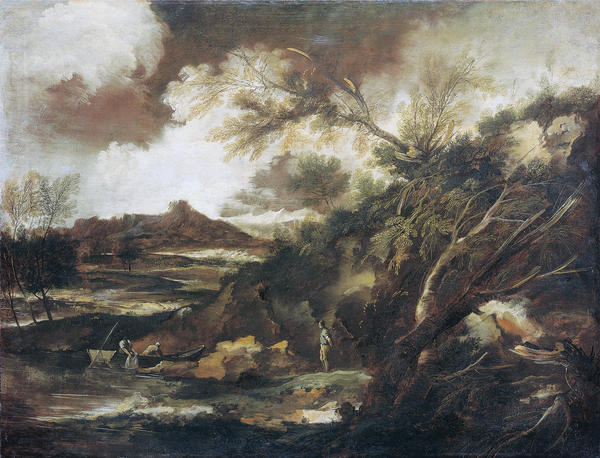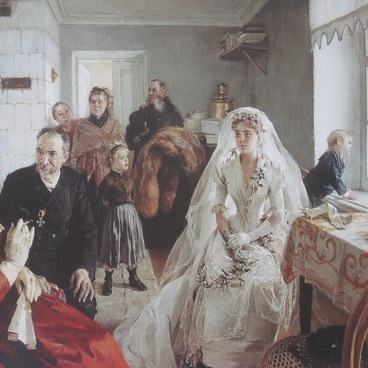Marco Ricci was a drawing artist and engraver originating from Italy, who lived for 53 years and managed to travel to England, Holland and France. Among his interests were palace interior design and theater stage design, and even caricature.
Painter Sebastiano Ricci had a strong influence on his nephew; he taught him at a studio as apprentice. Moreover, the young man studied the legacy of his peers, including Alessandro Magnasco, Gaspard Dughet, Claude Lorrain, Pieter Mulier and Salvator Rosa. His early works imitate those masters, and there is only a hint of originality in them.
However, as time went by, the author’s talent revealed itself in a proto-Romantic interpretation of scenery. The paintings Christ on the Sea of Galilee, A Landscape with Washerwomen and Monks or A Storm at Sea were created in that manner. Among them was After a Storm that can be admired at the Serpukhov Museum of History and Art.
Marco Ricci used oil paints of the brown, gray and green color arrays, which do not divert attention from expressive brushwork. This modest palette only emphasizes the buoyancy of the spots and lines.
Nevertheless, parts of the composition do not have clear-cut boundaries. The waves are rolling over towards massive rocks with ragged trees on them, which are still trying to reach the turbulent clouds with their foliage. It was the master’s way to show the attractive power and the unavoidable merging of elements.
In the opinion of scholars, the artist was trying to show interaction of primary elements, i.e. air, earth, water and fire. The latter can be identified in the reddish glow of the bonfire on the plants.
The people on the shore can hardly be called the central characters of the scene. The man in the middle is only a beholder of the spectacle. Blaise Pascal said about the Baroque man that he is ‘a creature suspended between everything and nothing’.
In their turn, the fishermen in the boat are more like extras who came out on stage where nature, the leading lady, had just finished her performance.
It is worth noting that the atmosphere of the canvas After a Storm conveys not so much searches for a personal style as the time of transition to Rococo, which impacted so many areas of self-expression. For instance, infatuation with Antiquity and rural idyll infuses paintings with sensuality and melancholic elegance. Contrasts and geometric accuracy give way to subdued tints and convoluted contours. Ultimately, dark icons and realistic portraits were removed from walls, as they were replaced with generalized and fictional characters.
Painter Sebastiano Ricci had a strong influence on his nephew; he taught him at a studio as apprentice. Moreover, the young man studied the legacy of his peers, including Alessandro Magnasco, Gaspard Dughet, Claude Lorrain, Pieter Mulier and Salvator Rosa. His early works imitate those masters, and there is only a hint of originality in them.
However, as time went by, the author’s talent revealed itself in a proto-Romantic interpretation of scenery. The paintings Christ on the Sea of Galilee, A Landscape with Washerwomen and Monks or A Storm at Sea were created in that manner. Among them was After a Storm that can be admired at the Serpukhov Museum of History and Art.
Marco Ricci used oil paints of the brown, gray and green color arrays, which do not divert attention from expressive brushwork. This modest palette only emphasizes the buoyancy of the spots and lines.
Nevertheless, parts of the composition do not have clear-cut boundaries. The waves are rolling over towards massive rocks with ragged trees on them, which are still trying to reach the turbulent clouds with their foliage. It was the master’s way to show the attractive power and the unavoidable merging of elements.
In the opinion of scholars, the artist was trying to show interaction of primary elements, i.e. air, earth, water and fire. The latter can be identified in the reddish glow of the bonfire on the plants.
The people on the shore can hardly be called the central characters of the scene. The man in the middle is only a beholder of the spectacle. Blaise Pascal said about the Baroque man that he is ‘a creature suspended between everything and nothing’.
In their turn, the fishermen in the boat are more like extras who came out on stage where nature, the leading lady, had just finished her performance.
It is worth noting that the atmosphere of the canvas After a Storm conveys not so much searches for a personal style as the time of transition to Rococo, which impacted so many areas of self-expression. For instance, infatuation with Antiquity and rural idyll infuses paintings with sensuality and melancholic elegance. Contrasts and geometric accuracy give way to subdued tints and convoluted contours. Ultimately, dark icons and realistic portraits were removed from walls, as they were replaced with generalized and fictional characters.



